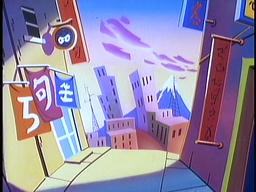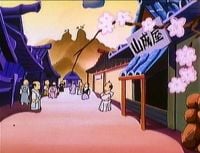Sayonara: Difference between revisions
From the Super Mario Wiki, the Mario encyclopedia
Jump to navigationJump to search
No edit summary |
(Added Hebrew name.) |
||
| (6 intermediate revisions by 3 users not shown) | |||
| Line 1: | Line 1: | ||
{{location infobox | {{location infobox | ||
|image=[[File:Sayonara SMBSS.png|256px]] | |image=[[File:Sayonara SMBSS.png|256px]] | ||
| | |first_appearance=''[[The Super Mario Bros. Super Show!]]'' - "[[Mario Meets Koop-zilla]]" (1989) | ||
| | |latest_appearance=''The Super Mario Bros. Super Show!'' - "[[Karate Koopa]]" (1989) | ||
| | |greater_location=[[Mushroom Kingdom]] | ||
|inhabitants=[[Ninji]]s, various | |inhabitants=[[Ninji]]s, various humans, [[Dr. T. Garden]], [[Misaki]] | ||
}} | }} | ||
'''Sayonara''' is an oriental city featured in two episodes of ''[[The Super Mario Bros. Super Show!]]'', "[[Mario Meets Koop-zilla]]" and "[[Karate Koopa]]". In the former, the city is a modern metropolis filled with large buildings, though the latter portrayal displays an older feudal town. Many [[Ninji]]s are shown to reside in the older-looking incarnation of the town. | |||
'''Sayonara''' is an oriental city featured in two episodes of ''[[The Super Mario Bros. Super Show!]]'', "[[Mario Meets Koop-zilla]]" and "[[Karate Koopa]]". In the former, the city | |||
Sayonara is heavily based on the real-world country, [[Japan]]. Its name, Sayonara, is a Japanese translation for "goodbye" | Sayonara is heavily based on the real-world country, [[Japan]]. Its name, Sayonara, is a Japanese translation for "goodbye," which describes how [[Bowser|Koop-zilla]] destroys the entire location. | ||
[[File:SayonaraKarateKoopa.jpg|thumb|left|Sayonara as it appears in "Karate Koopa"]] | |||
[[File:SayonaraKarateKoopa.jpg|thumb|left|Sayonara | |||
==Names in other languages== | ==Names in other languages== | ||
{{foreign names | {{foreign names | ||
| | |ChiS=萨约纳拉 | ||
|ChiSR=Sàyuēnàlā | |||
|ChiSM=Sayonara | |||
|ChiSC=<ref>{{cite|language=zh-hans|url=www.youtube.com/watch?v=-GRj26V2PLg|title=超级马里奥兄弟 - 马里奥会见Koop-Zilla {{!}} Learn Chinese {{!}} Cartoons in Mandarin|author=超级马里奥兄弟 - WildBrain|publisher=YouTube|date=September 7, 2019|accessdate=June 20, 2024}}</ref> | |||
|Fre=Sayonara | |||
|FreC=<ref>[https://www.youtube.com/watch?v=qc-VodvXep8&list=PLaFoLvczabwZT9mEcsRppZJRvNoW4czwg&index=18 Super Mario Bros 018 Mario rit jaune]</ref> | |||
|Ger=Sayonara | |||
|GerC=<ref>[https://www.youtube.com/watch?v=FjyQiUOdPtU&list=PLn0Cm-QzTZcYMFil7DnnbYQJlk7qccB4H&index=40 The Super Mario Bros Super Show! Folge 34 Die Wahrsagerin / Mario trifft Koopzilla]</ref> | |||
|Heb=סיונארה | |||
|HebR=Syvnarh | |||
|HebM=Sayonara | |||
|HebC=<ref>[https://www.youtube.com/watch?v=l7ePrjko7o4 האחים סופר מריו (1989) - (The Super Mario Bros. Super Show! - Hebrew Dub) - S01E18]</ref> | |||
|Ita=Sayonara | |Ita=Sayonara | ||
|ItaC=<ref>[https://www.youtube.com/watch?v=xMgQjZBRIAY&list=PLfqlJqOLcWeNSwLfKFx8PK4rPU8mfnAAX&index=6 Super Mario (1ª serie animata ITA) - L'arte del karate]</ref> | |||
|Por=Sayonara | |||
|PorC=<ref>[https://www.youtube.com/watch?v=yeG8BHMoT10&list=PLwzf4mOPE8BlhZQzQNfBFjrkJrrocv7kU&index=39 Super Mario Bros. Super Show! - Mario Encontra Koop-Zilla / A Cartomante (Dublado)]</ref> | |||
|Rus=Сайонара | |||
|RusR=Sajonara | |||
|RusM=Sayonara | |||
|RusC=<ref>[https://www.youtube.com/watch?v=6MYpnUNrNB8 супершоу супербратьев марио рен тв оф.перевод]</ref> | |||
|Spa=Sayonara | |||
|SpaC=<ref>[https://www.youtube.com/watch?v=xxbPMSE6B50 Mario conoce a Koop-Zilla | Dibujos Para Niños]</ref> | |||
|Swe=Sayonara | |||
|SweC=<ref>[https://www.youtube.com/watch?v=RU67q-59L64&list=PLxFcguXyn2Gq_SVmc3CbdYhMEduSfFfox&index=28 Super Mario Bros Super Show - Episode 28 - Swedish]</ref> | |||
}} | }} | ||
Latest revision as of 14:53, February 7, 2025
| Sayonara | |
|---|---|

| |
| First appearance | The Super Mario Bros. Super Show! - "Mario Meets Koop-zilla" (1989) |
| Latest appearance | The Super Mario Bros. Super Show! - "Karate Koopa" (1989) |
| Greater location | Mushroom Kingdom |
| Inhabitants | Ninjis, various humans, Dr. T. Garden, Misaki |
Sayonara is an oriental city featured in two episodes of The Super Mario Bros. Super Show!, "Mario Meets Koop-zilla" and "Karate Koopa". In the former, the city is a modern metropolis filled with large buildings, though the latter portrayal displays an older feudal town. Many Ninjis are shown to reside in the older-looking incarnation of the town.
Sayonara is heavily based on the real-world country, Japan. Its name, Sayonara, is a Japanese translation for "goodbye," which describes how Koop-zilla destroys the entire location.
Names in other languages[edit]
| Language | Name | Meaning | Notes |
|---|---|---|---|
| Chinese (simplified) | 萨约纳拉[1] Sàyuēnàlā |
Sayonara | |
| French | Sayonara[2] | - | |
| German | Sayonara[3] | - | |
| Hebrew | סיונארה[4] Syvnarh |
Sayonara | |
| Italian | Sayonara[5] | - | |
| Portuguese | Sayonara[6] | - | |
| Russian | Сайонара[7] Sajonara |
Sayonara | |
| Spanish | Sayonara[8] | - | |
| Swedish | Sayonara[9] | - |
References[edit]
- ^ 超级马里奥兄弟 - WildBrain (September 7, 2019). 超级马里奥兄弟 - 马里奥会见Koop-Zilla | Learn Chinese | Cartoons in Mandarin. YouTube (Simplified Chinese). Retrieved June 20, 2024.
- ^ Super Mario Bros 018 Mario rit jaune
- ^ The Super Mario Bros Super Show! Folge 34 Die Wahrsagerin / Mario trifft Koopzilla
- ^ האחים סופר מריו (1989) - (The Super Mario Bros. Super Show! - Hebrew Dub) - S01E18
- ^ Super Mario (1ª serie animata ITA) - L'arte del karate
- ^ Super Mario Bros. Super Show! - Mario Encontra Koop-Zilla / A Cartomante (Dublado)
- ^ супершоу супербратьев марио рен тв оф.перевод
- ^ Mario conoce a Koop-Zilla | Dibujos Para Niños
- ^ Super Mario Bros Super Show - Episode 28 - Swedish
